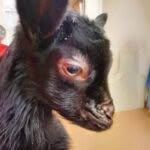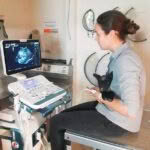5 types of bloat to watch out for (from treatable to deadly)
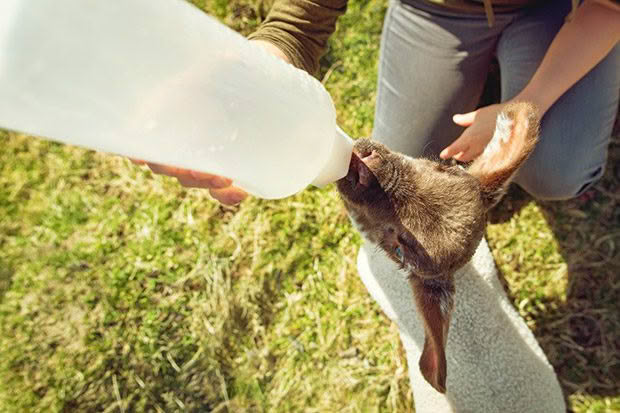
Anyone who raises lambs or goat kids will be familiar with the dreaded bloat. Here’s how to treat the different types you may see.
Words: Dr Sarah Clews, BVSc
Bloat in baby ruminants is often approached as the deadly type that affects the abomasum (the stomach chamber in ruminants that processes milk). However, there are many different causes, and vets can tailor treatment to help an animal recover.
1. Abomasal bloat
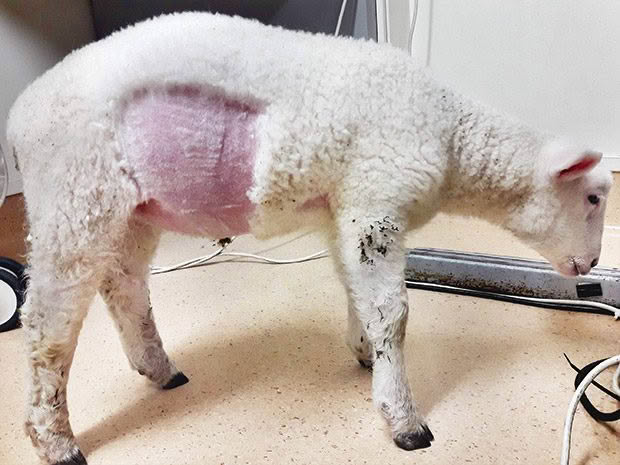
This lamb is standing with its legs wide, similar to a rocking horse, one of the signs of abomasal bloat.
This common issue only affects hand-reared baby ruminants and carries a 90-100% risk of death. Some studies suggest it causes the deaths of up to 30% of bottle-reared lambs.
SYMPTOMS
• sudden bloating, within 30-60 minutes of a milk feed;
• may have diarrhoea, but not always;
• often seems very sudden, but observant owners may notice a slow build-up in gut size over 2-3 feeds;
• wide-legged ‘rocking horse’ stance;
• bright and alert until they start struggling to breathe as it worsens (fast breathing with an open mouth).
Affected animals are almost always on a small number of large-volume feeds, and the risk is highest as volumes increase, often around weaning.
TREATMENT
This is an emergency. Animals require immediate vet care or they will die quite quickly. Feed yogurtised milk to prevent it recurring.
2. Milk rumenitis
- The classic balding of the eyes, nose and ears sometimes seen with chronic/long term milk rumenitis.
This disease is rarely seen in calves but is common in lambs and kids. It occurs when milk accidentally goes into the rumen (the stomach chamber that processes grass and water) instead of the abomasum.
SYMPTOMS
• a slow, grumbling bloat, over days-weeks;
• nausea and reluctance to drink;
• a sloshy, fluid-filled tummy, 6+ hours after drinking (when it should be empty);
• bald patches on the head, ears and around the eyes;
• scant, clay-like faeces;
• a history of other illnesses, such as hypothermia or pneumonia.
Young lambs and goats need a strong suck on warm fluid to trigger the body to direct it to the correct chamber of the stomach. Affected animals usually have a history of a weak suck, lethargy from an illness, are receiving milk that’s too cold, drinking from a bucket or bowl, or being syringe or tube-fed.
TREATMENT
Treat for any underlying issue and the milk rumenitis. If this disease continues over a prolonged period, it causes malnutrition and dehydration, and it can be difficult to get an animal back to full health.
3. Abdominal catastrophe
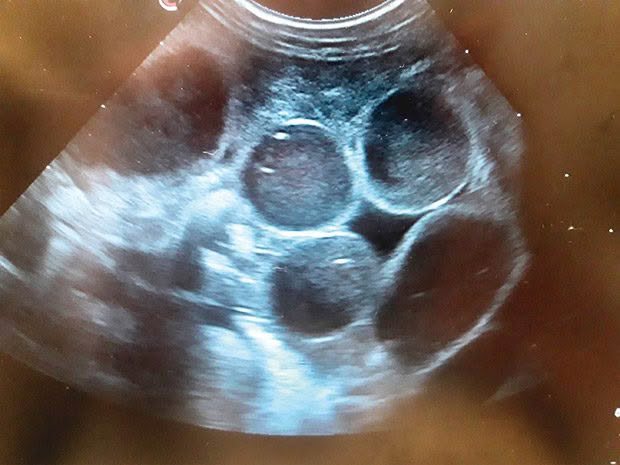
Using ultrasound to diagnose a twisted gut.
A twisted gut (known as an intussusception) is more common in baby ruminants than in kittens and puppies. Toxic compounds build up in the blood, sending the animal into shock and killing parts of the bowel.
SYMPTOMS
• varying degrees of bloat – mild to severe;
• often in the first week or two of life, or following a sudden diet change;
• very painful abdomen immediately after drinking;
• lambs may hunch and be quiet while kids generally cry out, rolling, kicking;
• may or may not seem hungry;
• may have diarrhoea or no faeces;
• eventually gums and conjunctiva turn a brick red colour;
• very fast breathing rate;
• shock, death.
TREATMENT
An ultrasound is needed to diagnose the condition. The only treatment is surgery, but it must be done very quickly. Unfortunately, symptoms are often not noticed soon enough and euthanasia is the only option as these babies suffer immensely.
4. Constipation
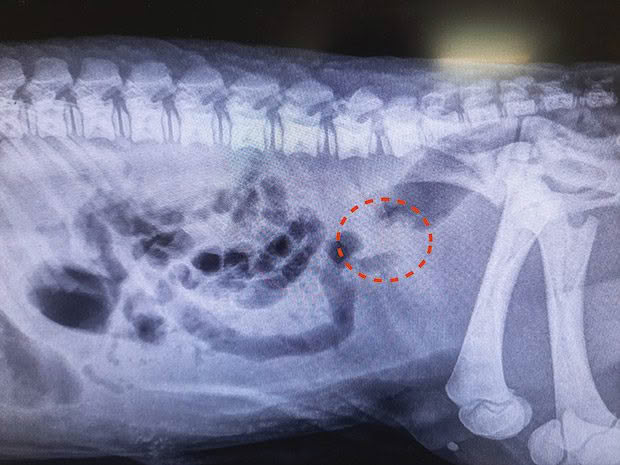
Constipation as seen on x-ray, from the side.
This is usually seen in the first few days of life, as babies transition from colostrum to milk or after a diet change. Severe dehydration will also cause constipation.
SYMPTOMS
• mild bloat;
• reduced appetite;
• sore after a drink;
• nothing coming out the back end;
• hunched back and pain when you press up under the pelvis.
TREATMENT
Stock need fluids and a warm soapy enema. Unfortunately, when severe, constipation can look very similar to an abdominal catastrophe. It’s crucial to get an ultrasound or x-ray to guide treatment to prevent unnecessary suffering.
5. Toxic bloat
Caused by the growth of certain bacteria in the gut that release toxins which damage the blood vessels, gut, kidney, and brain.
SYMPTOMS
• mild-moderate bloat;
•very dull and lethargic;
• flat ears, head hanging low, apparent blindness;
•brick red conjunctiva around the eye;
•very fast breathing rate.
TREATMENT
Unless caught very early, this bloat is almost always untreatable. Killing the bacteria releases even more toxins into the blood. Animals quickly go into shock and it can look very similar to an advanced abdominal catastrophe. The most common option is humane euthanasia.
SARAH’S TIPS FOR PREVENTING BLOAT
• Add a probiotic of a non-gas producing bacteria (eg Bifidobacterium animalis – avoid using acidophilus yogurt) to milk. Also a good option if an animal has had antibiotics, to help repopulate the gut with ‘good’ bacteria.
• Yogurtise milk to reduce the risk of abomasal bloat – note, it’s safe to use acidophilus yoghurt in this process.
• Mimic the ewe: keep feeds small and frequent, and wean by reducing the volume and number of feeds.
• Practise good hand-rearing techniques: be hygienic, feed milk at the right temperature, don’t have the teat opening too big (so milk doesn’t come out too fast).
• Vaccinate early, using a broad-spectrum vaccine. Newer 10-in-1 vaccines cover some bacterial species that may cause bloat.
4 STRATEGIES FOR TREATING BLOAT
Treatment is tailored to address the actual cause of the bloat – a vet will need to make a diagnosis – but some things apply to all causes.
Fluids: Rehydration gets the stomach and intestines working properly again. However, feeding electrolytes by mouth will worsen the condition if the stomach isn’t emptying (due to bloat). You need a vet to administer fluids under the skin or directly into the bloodstream.
Sugar: Bottle-reared babies will die quickly due to low blood sugar if they can’t drink. Have glucose powder on hand and apply it to the gums frequently as a temporary measure to keep blood sugar levels up for a short time. Don’t feed them a sugary syrup down the throat as it will make their bloat worse.
Baking soda: Baking soda or bicarb acts as a buffer for the stomach lining, protecting it from ulceration when it’s inflamed as an antacid does in people. Add small amounts of baking soda to 10ml (2 tsp) of water until it stops dissolving – feed the liquid orally.
Vet-only medication: Antibiotics and pain relief medication are essential in some cases. The type of drugs will depend on the cause. Other drugs may be required, for example, to stimulate the stomach to empty properly.
4 UNUSUAL CAUSES OF A DISTENDED ABDOMEN
• enlarged liver;
• ruptured bladder;
• blockage by foreign body, eg eating trash;
• genetic defects, such as atresia ani (defect of or absence of the anus).
Love this story? Subscribe now!
 This article first appeared in NZ Lifestyle Block Magazine.
This article first appeared in NZ Lifestyle Block Magazine.
